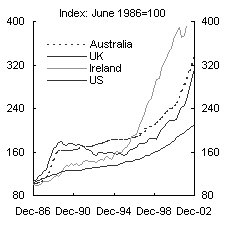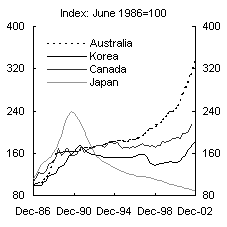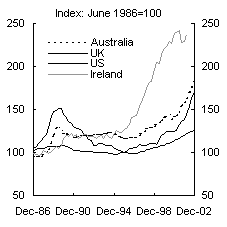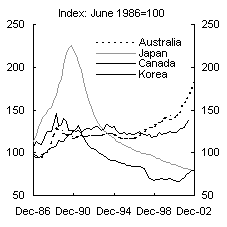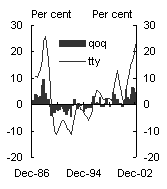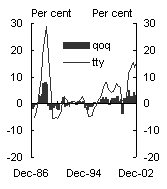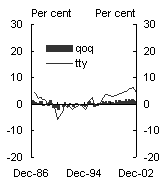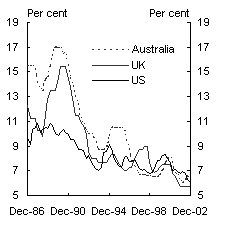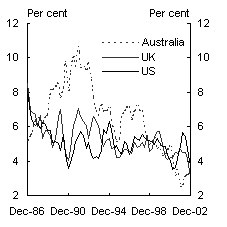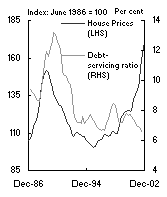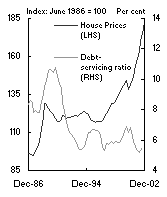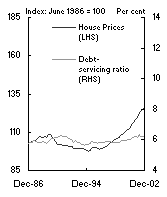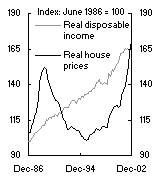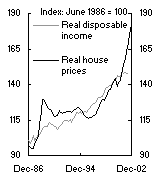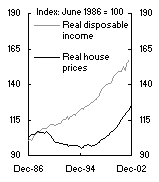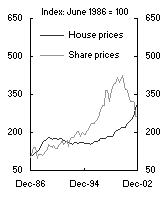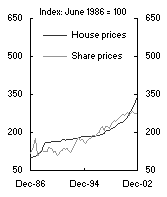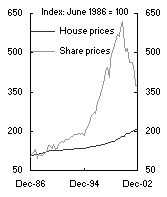This article examines developments in house prices in a number of countries over recent years. It shows that while the magnitude of house price movements have differed across countries, the recent trend of rising prices in Australia has also been experienced in some other developed countries.
This article also examines changes in housing affordability arising from changes in house prices, interest rates, housing debt and disposable income in the United Kingdom, Australia and the United States. Finally, the relationship between house and share prices is also discussed.
Introduction
Calendar 2001 witnessed a US recession and a global economic slowdown that were mild relative to the experience of the early 1980s and 1990s. The muted nature of the slowdown reflected resilient household consumption in many developed economies, a factor that also provided the foundation for the subsequent mild recovery in activity. The sustained strength of household consumption in many developed economies appears to have been supported by low interest rates and the positive wealth effects of rising house prices, notwithstanding sharp declines in equity prices.
As Dr Alan Greenspan, Chairman of the Board of Governors of the US Federal Reserve System, has noted:
'the extraction of equity from homes has been a significant support to consumption during a period when other assets were declining sharply. Were it not for this phenomenon, economic activity would have been notably weaker in the wake of decline in the value of household financial assets.' 1
The rise in house prices across a number of developed countries has supported household consumption and overall economic growth (including through housing construction) during a period of relative weakness in the global economy. Nevertheless, it has also raised concerns that house price bubbles may be forming in these markets.2 Concerns about the formation of bubbles reflect the economic disruption associated with the bursting of past asset price (including house price) bubbles in the late 1980s and early 1990s in the United Kingdom, Japan, Canada and the Nordic countries. Past corrections have generally been triggered by a number of factors (or combinations thereof) including: higher interest rates; a fall in household income; and share market corrections. In the current global macroeconomic climate of uncertain income growth and volatile equity prices, any sudden unwinding of house prices could cause a sharp fall in consumption demand in many developed countries, although the contribution of housing to overall wealth varies widely between countries.3 In addition, a decline in house prices has the potential to reduce construction of new houses, which would also impact negatively on the purchase of durable goods for houses.
The effects of any potential downturn in house prices could be exacerbated by the increase in the marginal propensity to consume from household wealth that has been facilitated by the increasing use of houses as securities for loans over the last decade.For example, in the US, mortgage refinancing is currently at its highest level ever4, valued at about US$1.75 trillion in 2002.5 Refinancing applications in the US currently represent around 70 per cent of all mortgage applications, compared to around 30 per cent in December 2000. The impact on US household consumption from declining housing prices would appear to be slightly higher than the impact from lower share prices, although the relative impacts are not clear.6
This article examines recent developments in international house prices and focuses on housing affordability and its determinants: house prices; mortgage interest rates; household disposable income; and housing debt levels. The impact of share price movements on house prices is then examined. The Appendix provides further context for the recent increases in house prices in Australia.
Recent developments in international house prices
Chart 1 compares recent developments in nominal house prices in a number of developed countries including Australia. While house prices have risen over the last five years in Australia, they have also risen in a number of other developed countries, although this phenomenon has not been global. For instance, Japan has experienced substantial deflation in house prices since the early 1990s and house prices in Hong Kong and Singapore have fallen substantially over the last five years.
Chart 1: Nominal prices for existing houses7
|
|
|
Source: Australian Bureau of Statistics (ABS) for Australia; Office of Federal Housing Enterprise Oversight (OFHEO) for the US; Halifax for the UK; Bank of International Settlements for Ireland and Canada; CEIC Database for Japan and Korea.
Chart 2 compares real house prices,8 and shows that house price increases have been more muted in real terms. Chart 2 also shows that some countries have experienced extended periods of falling real house prices over the period shown.
Chart 2: Real (CPI adjusted) prices for existing houses
|
|
|
Source: Australian Bureau of Statistics (ABS) for Australia; Office of Federal Housing Enterprise Oversight (OFHEO) for the US; Halifax for the UK; Bank of International Settlements for Ireland and Canada; CEIC Database for Japan and Korea.
Table 1 summarises developments in house prices for selected countries over recent years. In particular, Ireland, the UK, Australia, and to a lesser extent, the US have all experienced relatively strong growth in property prices in both nominal and real terms.
Table 1: Nominal and real (CPI adjusted) house price movements for selected countries to the December quarter 2002
|
Nominal
|
Real
|
|||
|
Last five years
|
Last two years
|
Last five years
|
Last two years
|
|
|
(percentage change)
|
(percentage change)
|
|||
| Ireland(a) |
103.4
|
18.2
|
65.6
|
6.1
|
| United Kingdom |
77.0
|
42.4
|
58.5
|
37.4
|
| Australia |
70.0
|
36.9
|
46.3
|
28.8
|
| United States |
38.3
|
15.2
|
23.3
|
10.6
|
| Canada(b) |
19.3
|
13.1
|
11.2
|
10.9
|
| Korea |
15.8
|
27.1
|
-2.7
|
17.9
|
| Japan |
-21.8
|
-9.2
|
-20.0
|
-7.7
|
| Singapore |
-27.0
|
-15.8
|
-28.2
|
-16.1
|
| Hong Kong |
-60.6
|
-23.9
|
-54.8
|
-19.8
|
(a) Data for Ireland are available to the March quarter 2002 only. Consequently, percentage changes have been calculated from the March quarter 1997 and the March quarter 2000 to the March quarter 2002.
(b) Data for Canada are available to the June quarter 2002 only. Consequently, percentage changes have been calculated from the June quarter 1997 and the June quarter 2000 to the June quarter 2002.
The remainder of this article concentrates on how demand side factors in the UK, the US and Australia have influenced real house prices and housing affordability.
Chart 3: Growth in real house prices
|
United Kingdom |
Australia |
United States |
|
|
|
|
Source: Australian Bureau of Statistics (ABS) for Australia; Office of Federal Housing Enterprise Oversight (OFHEO) for the US; Halifax for the UK; Bank of International Settlements for Ireland and Canada; CEIC Database for Japan and Korea.
Both Australia and the UK experienced a boom in real house prices in the late 1980s. Following that peak, the UK experienced a large fall in real house prices of over 30 per cent over the period to late 1995 (Chart 2), while real house prices in Australia declined by a little less than 10 per cent over this period. Despite not experiencing any boom in real house prices in the late 1980s, real prices in the US declined by around 9 per cent to late 1995 (Chart 2). As shown in Table 1, the UK, Australia and to a lesser extent the US have all experienced real house price growth over the late 1990s and early in the 2000s. One major common factor experienced by all three countries over the last decade has been a structural move to a much lower interest rate environment.
In the UK, the late 1980s boom was associated with high demand from first home buyers, who accounted for over half of mortgage loans. Nearly thirty per cent of these first home buyers did not make a deposit on their house, making them extremely vulnerable to rising interest rates and negative owners' equity. Indeed, the recession of the early 1990s saw distress in parts of the UK market, with some new home buyers seeing their equity turn negative as house prices fell below the mortgage outstanding. First home buyers in the UK have not played such an important role in the demand for houses in the current episode. Around forty per cent of mortgage loans in the UK are currently to first time buyers, with an insignificant number of these making zero down payments. Compared with the late 1980s, the current UK housing market appears to be less susceptible to a serious deterioration in the equity of first home buyers in the event of any downturn in house prices.
In Australia, there are a number of major differences between the house price boom in the late 1980s and the current situation.9 During the late 1980s, the boom was largely concentrated over the two year period to the March quarter 1989, when real house prices grew by nearly 36 per cent. This compares with the recent rise in real house prices being spread over a much longer period, with real prices growing by over 46 per cent in the five years to the December quarter 2002.
Another major difference between the 1980s and the recent episode relates to the coverage of house price growth across Australia. In the late 1980s boom, house price growth was more concentrated in Sydney and Perth and to a lesser extent Melbourne, whereas the more recent period of price increases has spread widely (although not evenly) to most Australian capital cities and to many coastal zones. In addition, investors in the Australian property market have been much more prevalent during the recent run up in prices as against in the 1980s.10 This partly reflects the relative ease and lower cost of investors entering the housing market than in the late 1980s. The introduction of the Goods and Services Tax in Australia in July 2000 and the associated First Home Owners' Scheme has also impacted on the Australian housing market.11
Real house prices in the US have been more stable than in the UK or Australia since the late 1980s. In contrast to Australia or the UK, shares rather than houses make up the major proportion of household wealth in the US. Share prices rose more st
rongly than house prices in the US during the economic boom of the 1990s, despite lower interest rates, higher income, and improved housing affordability there.
In the US, the rate of increase in housing prices slowed in very late 2002 and there are tentative signs that the rate of increase in house prices may have slowed in the UK and Australia in early 2003.
Housing affordability
Housing affordability is a measure of the ongoing costs of purchasing housing in relation to income. Affordability and accessibility of housing are associated with: the price of housing; household disposable income; mortgage interest rates; and the amount borrowed. Despite the rapid rise in house prices in the UK, Australia and the US over recent years, a combination of lower interest rates and higher disposable income has meant that houses in these countries are still more affordable than they were during the boom of the late 1980s.
Interest rates and the debt-servicing ratio
A house is an asset that delivers consumption services over many periods. House prices therefore are affected by current and expected future interest rates. Other things being equal, a higher interest rate lowers the price that people are prepared to pay for a house. On the other hand, if house prices and disposable income are unchanged, a lower interest rate improves the affordability of housing.
In various countries there is a mix of variable and fixed interest rates used to finance housing. The main mortgage interest rate in the US is the 30 year fixed mortgage interest rate. In Australia, the major lending rate for housing is the variable standard lending rate and in the UK the benchmark is the variable mortgage lending rate for Building Societies.
Chart 4 shows that the commonly used mortgage interest rates, in both nominal and real terms, are currently substantially lower than those of the late 1980s and early 1990s for all three countries. The move to a much lower inflationary environment has allowed interest rates to be substantially reduced. In addition, increased competition in financial markets has also reduced the margins that mortgage providers receive between their cost of funds and mortgage interest rates. Sustained lower interest rates appear to have been a major factor supporting higher house prices. Lower mortgage interest rates have substantially improved the capacity of households to service any given loans.
Chart 4: Mortgage Interest Rates
|
Nominal |
CPI Inflation Adjusted(a) |
|
|
|
(a) The CPI inflation adjusted interest rate for Australia is derived by using a CPI excluding the New Tax System series constructed by the Treasury.
Source: Federal Reserve for the US; RBA Bulletin for Australia; and the UK Building Societies for the UK.
The debt-servicing ratio provides an indication of households' ability to service mortgage repayments given the level of interest rates, the size of the mortgage and disposable income.
The sustained fall in interest rates, combined with rising house prices, has pushed up the ratio of mortgage debt to income. Debt to income ratios have also increased substantially due to the increase in the availability of different forms of mortgage equity withdrawal.
Increases in real house prices to date in Australia, the UK and the US appear to be currently sustainable when viewed solely from the perspective of household debt-servicing capacity (Chart 5). Nevertheless, these debt-servicing ratios are averages and some households may face difficulties in servicing mortgages.
Chart 5: Real house prices and the debt-servicing ratio
|
United Kingdom |
Australia |
United States12 |
|
|
|
|
Source: ABS for Australia; Halifax and NSO for the UK; and OFHEO and Federal Reserve Bank for the US; and Commonwealth Treasury calculations.
Since the 1990 peak, the debt-servicing capacity of households in the UK and Australia has improved significantly, as evidenced by the halving of the debt-servicing ratio. This fall in the debt-servicing ratio despite a period of rising house prices is in sharp contrast to the experience in the late 1980s. The debt-servicing ratio in the US has not changed significantly over the period shown.
While debt servicing ratios have improved significantly for the UK and Australia and remained steady for the US, the average housing mortgage size has increased substantially over the 1990s (Chart 6). The increase in the average housing mortgage size is likely to make housing borrowers more sensitive to any future increases in interest rates or declines in disposable income.
Chart 6: Average first home buyers mortgage loan size
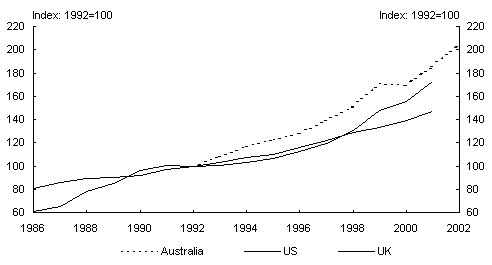
Sources: Office of the Deputy Prime Minister for the UK; ABS for Australia (data are only available from 1992); and National Realtors Association for the US.
Disposable income
Higher disposable income increases overall purchasing power including demand for houses, and is thus expected to raise house prices.13 On the other hand, for given house prices and interest rates, any increase in disposable income boosts housing affordability.
All three countries have also experienced significant growth in real disposable income over the 1990s. Real disposable income increased by about 66 per cent in the UK, 57 per cent in the US and by 48 per cent in Australia since 1986 (Chart 7).
Chart 7: Real house prices and real disposable income
|
United Kingdom |
Australia |
United States |
|
|
|
|
Source: ABS for Australia; Halifax and NSO for the UK; and OFHEO and Bureau of Economic Analysis for the US.
Real disposable income has grown faster than real house prices in the US and at about the same rate in the UK over the period since 1986. In Australia, real house prices have tended to grow faster than real disposable income, especially over the last year.14
Chart 8 shows the ratio of average house prices to average annual earnings15 in the three countries. The ratio is higher in the US than in Australia or the UK. Average house prices in Australia in the September quarter 2002 were 6.8 times average annual earnings, compared to a ratio of about 4-5 times during the period to the mid 1990s. The ratio in the UK rose to nearly 4.9 in the late 1980s before falling to below 3 in the mid 1990s. It stood at about 4.6 in the September quarter 2002. The ratio has increased gradually from around 6 to almost 8 in the US throughout the period since 1986.
Chart 8: Ratio of median house prices to average annual earnings
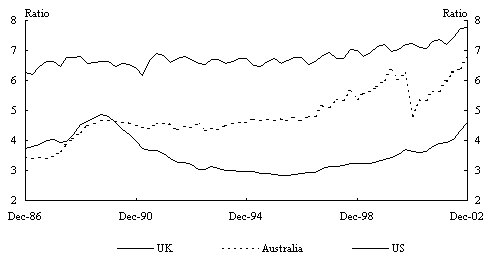
Source: ABS for Australia; ONS and Halifax for the UK; and Datastream and OFHEO for the US.
Housing affordability
Combining the above-mentioned factors of mortgage interest rates, the level of borrowing, house prices and disposable income, housing affordability is the ratio of average household disposable income to the income necessary to meet repayments on an average established house purchased by a first home buyer. An increase in the index represents an improvement in affordability.
Chart 9 shows the affordability indices are still significantly above the late 1980s troughs in the UK and Australia despite higher housing prices in each country.
Chart 9: Housing affordability
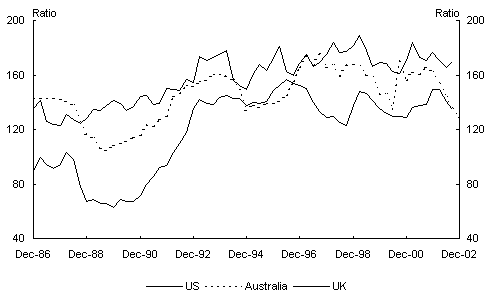
Source: Commonwealth Bank of Australia/Housing Industry Association for Australia; National Realtors Association for the US; Office of Deputy Prime Minister and the National Statistics Office (NSO) for the UK; and Commonwealth Treasury calculations.
In Australia, housing affordability decreased substantially prior to late 1989 when housing interest rates (which reached 17 per cent) and house price growth were both high. Substantial reductions in interest rates since 1990 have been the major factor working to improve housing affordability. The housing affordability index in Australia has declined over recent quarters due to higher house prices, but in the December quarter 2002 housing affordability was around 23 per cent higher than the trough reached in 1989.
In the US, housing affordability declined by nearly 12 per cent between 1987 and 1988 when interest rates averaged over 10 per cent. In 2002, mortgage interest rates in the US were around 6.5 per cent. The decline in interest rates and higher disposable incomes over the 1990s have supported affordability in the US, with the affordability index in the September quarter 2002 being about 23 per cent higher than in 1989.
In the UK, housing affordability declined by 39 per cent from the beginning of 1988 to the end of 1989. During this period, housing interest rates increased from around 10 per cent in the first half of 1988 to over 14 per cent by the end of 1989 and house prices grew by nearly 20 per cent over the same period. In 2002, the average mortgage interest rate in the UK was 5.75 per cent and the housing affordability index in the September quarter 2002 was around 105 per cent higher than in late 1989, although it has been declining over recent quarters.
House prices and share prices
The two major components of household wealth are financial and non-financial assets, proxied by deposits in financial institutions, shares and housing assets. Increases in asset valuations were the driving force behind the sharp increases in net household wealth during the 1990s in most developed economies. The effect of increases in wealth on consumption has been increasing over time, as financial institutions have provided instruments to allow wealth to be consumed in the current period.
A recent BIS study16 found a positive relationship between changes in share and house prices over the medium to longer term. This reflects the positive stock market wealth effect on housing demand more than offsetting any substitution effect between the two asset classes. However, the correlation between these assets is uncertain and often varies between countries due to different preferences. In addition, house prices are usually affected by country specific developments, whereas share prices are more prone to global influences.
Chart 10 shows the different trends between house and share prices in the UK, Australia and the US over the last fifteen years.
Chart 10: House prices compared with share prices
|
United Kingdom |
Australia |
United States |
|
|
|
|
Source: ABS and Datastream for Australia; OFEHO and Datastream for the US; and Halifax and Datastream for the UK.
While share prices in the US soared in the second half of the 1990s, they have corrected sharply since early 2000, although share prices in the US have still grown substantially more than house prices since 1986.
In the UK, share price growth has generally exceeded that of house prices, but the situation has reversed over recent quarters, with the share market correction and the strong increase in house prices since 2000.
In Australia, growth in share market prices has been much more muted than in the US. House price growth has been broadly similar to share price growth over the period since the share market correction in 1987.
While the sharp decline in global share prices since early 2000 is likely to have resulted in a move to the 'security' of bricks and mortar in the short term, as noted earlier, the wealth effect from the fall in global equity prices over the longer term may eventually reduce the demand for housing.
Conclusion
Over the last 15 years, different countries around the world have experienced varied movements in house prices. Countries such as the UK, Australia and to a lesser extent the US have experienced substantial house price growth (which has supported household consumption growth) over recent years, while other countries such as Japan have seen house prices fall substantially.
In the UK, Australia and the US, the move to a lower inflationary environment has allowed substantially lower interest rates. Lower int
erest rates combined with rising real disposable income has supported higher house prices and mortgage debt levels. Debt servicing ratios do not suggest that average households are currently under financial stress servicing their housing loans.
Lower interest rates and higher real disposable income mean that despite rises in house prices, housing is significantly more affordable now compared with the boom period in the late 1980s.
Nevertheless, new house owners have taken on higher levels of debt compared to their income. This makes them more vulnerable to any future interest rate increases (bearing in mind that interest rates are at near historical lows) or a loss in real disposable income. While there are signs that house price growth may have started to abate, any continuation of house price growth at rates experienced over recent years would reduce housing affordability.
Appendix
Dwelling ownership as part of australian household portfolios
This appendix provides some context for the recent increases in house prices in Australia. It presents data showing dwellings as part of household portfolios, the age distribution of home purchases and some disaggregation of debt servicing burdens.
The increases in housing prices over the last decade have contributed to growing household wealth. Chart A1 indicates the proportion of household wealth held in dwellings and its growth relative to total household wealth. The chart indicates that other forms of household wealth have grown as well as that held in the form of dwellings.
Chart A1: Household wealth
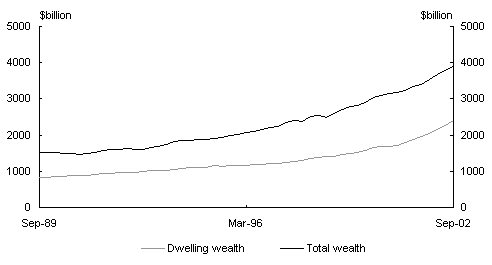
Source: Commonwealth Treasury.
More recently, public debate regarding rising residential prices has touched upon whether younger, first home owners have been squeezed out of the housing market. Table A1 presents a profile of home purchases by age cohort. These data indicate that the proportion of the under 35 year old cohort - the age group often considered most vulnerable to increasing house prices - did not change much over the course of the 1990s. The sharp increase in the proportion of 45-54 year olds purchasing homes over this period may reflect increased investor activity by this age group.
Table A1: Home purchase by age cohort

Source: ABS Survey of Income and Housing Costs.
Given the recent increase in Australian housing prices, there has been interest in what has happened to the structure of household debt. Chart A2 presents aggregate household liabilities as a ratio to household assets. This illustrates that since 1989 the ratio of liabilities to assets has risen (by around 50 per cent). The chart shows that in aggregate, household liabilities were less than 20 per cent of assets. That is, in spite of the increase in liabilities, in 2002 households held a little over five dollars of assets for every dollar of liability.
Chart A2: Ratio of household liabilities to assets
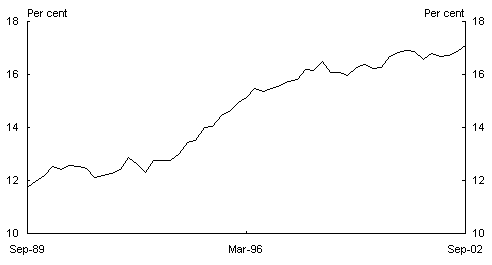
Source: ABS Cat. No 5232.0 Financial Accounts.
In a similar vein, Chart A3 presents the composition of household debt as a proportion of household income since 1990. This indicates both that debt as a ratio of income had increased and that the composition of debt has changed. Debt associated with owner occupied housing is the bulk of household debt and has grown as a proportion of income over the period. However, it is clear that debt related to investment in rental properties has grown substantially as a proportion of household debt portfolios.
Chart A3: Household debt*
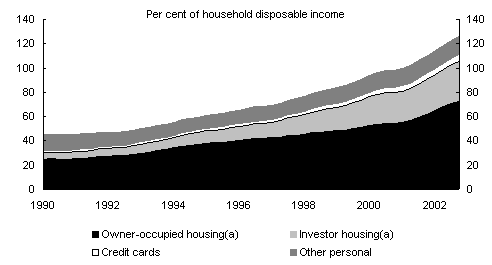
* excludes unincorporated enterprises.
(a) Shares based on bank lending data.
Source: Household Debt: What the Data Show, The Reserve Bank of Australia Bulletin, March 2003.
The increasing level of household debt related to dwellings raises the question of households' ability to service debt and whether increasing levels of aggregate debt have created financial stress for income groups. Table A2 presents data on mortgage repayments as a portion of household budgets by income quartiles (the fourth quartile being the highest income group). It indicates that for all income groups the ratio of repayments to income fell.
Table A2: Mortgage repayments/gross income for purchasers*

* Data for income quartile 1 is intentionally left blank as expenditure patterns do not reflect reported income. This may be because of access to savings or other sources of wealth, or because reported income includes low or negative business income. (ABS Year Book Australia 2003)
Source: ABS Survey of Income and Housing Costs.
- Testimony of Dr Alan Greenspan before the Joint Economic Committee, US Congress 13 November 2002.
- Concerns expressed in Australia have largely related to investment in medium density dwellings in the inner city markets of Sydney and Melbourne. For a comprehensive analysis of the increased role played by investors in the Australian housing market, see Recent Developments in Housing: Prices, Finance and Investor Attitudes, Reserve Bank of Australia Bulletin, July 2002.
- According to the IMF's World Economic Outlook April 2002, housing accounts for around 30-40 per cent of household wealth in Western Europe and almost 25 per cent in the US, compared with over 60 per cent in Australia (Commonwealth Treasury calculations).
- Refinancing is popular in the US because of the use of fixed interest rate mortgages. In such cases when interest rates are lowered, financing costs can be reduced by re-mortgaging. However, it is interesting to note that in the US, re-mortgaging is being used largely to increase debt outstanding and not to accelerate repayments.
- Dr Greenspan included this US Federal Reserve estimate in his remarks before the annual convention of the Independent Community Bankers of America on 4 March 2003.
- In the US, estimates of the effect of share prices on consumption range between 3-5 cents per dollar, whereas housing wealth's effect on consumption ranges between 4-6 cents per dollar. See Boone L, Giorno C and Richardson P (1998), Stock market fluctuations and consumption behaviour: some recent evidence, OECD Economics Department Working Papers, No. 208.
- In Australia, established houses are defined by the ABS as detached residential dwellings on their own block of land regardless of age (ie, including new homes sold as house/land packages and second hand houses). Figures for other countries are essentially compatible with Australian data.
- Consumer price index (CPI) adjusted.
- Some of the factors mentioned here are also contained in Recent Developments in Housing: Prices, Finance and Investor Attitudes, Reserve Bank of Australia Bulletin, July 2002.
- According to the ABS (Catalogue 5609: Housing Finance for Owner Occupation and Catalogue 5671: Lending Finance), about 30 per cent of the total lending in the hou
sing sector went to investors in 1989, compared with about 42 per cent in the first three quarters of 2002. Recent Developments in Housing: Prices, Finance and Investor Attitudes, Reserve Bank of Australia Bulletin, July 2002, provides additional information on the impact of investors on the housing market. - For additional information see, Preliminary assessment of the impact of The New Tax System, Commonwealth Treasury, Economic Roundup Autumn 2003.
- The US measure of the debt-servicing ratio incorporates both principal and interest repayments, whereas the UK and Australia measures are for interest repayments only. The US debt-servicing ratio would be even smaller if it applied to interest repayments only.
- Higher purchasing power not only raises house prices through higher demand for houses, but also increases demand for better quality housing. Such hedonic changes are not taken into account in this article.
- The real disposable incomes used are national aggregates rather than household disposable income. Many households in all three countries would have benefited from the increase in two income earning households.
- Average annual earnings are derived from the average weekly earnings of employees from these countries. Labour market data have been sourced from the ABS for Australia, NSO for the UK and Datastream for the US.
- Gregory Sutton, Bank of International Studies, Explaining Changes in House Prices, Quarterly Review, September 2002.
